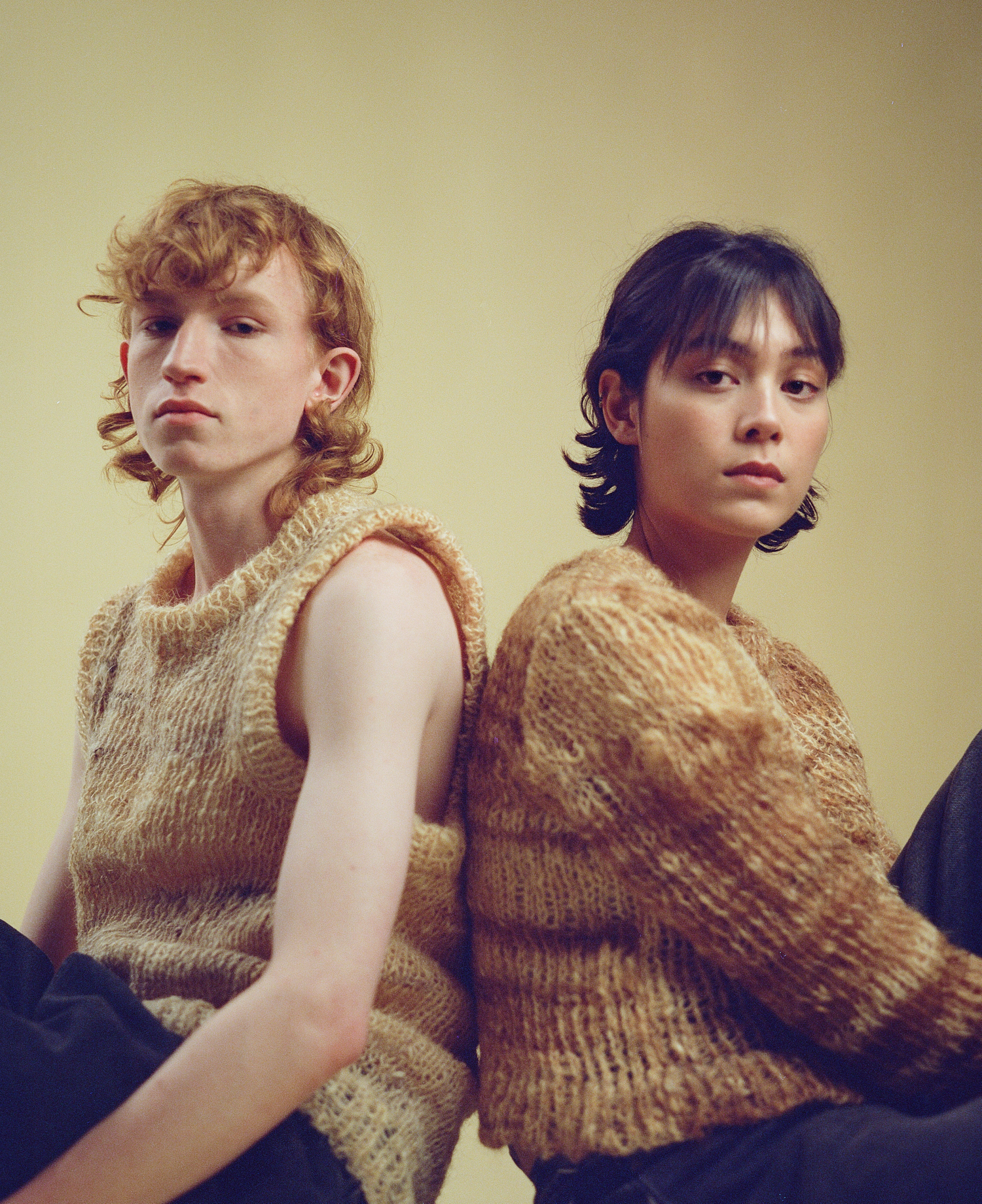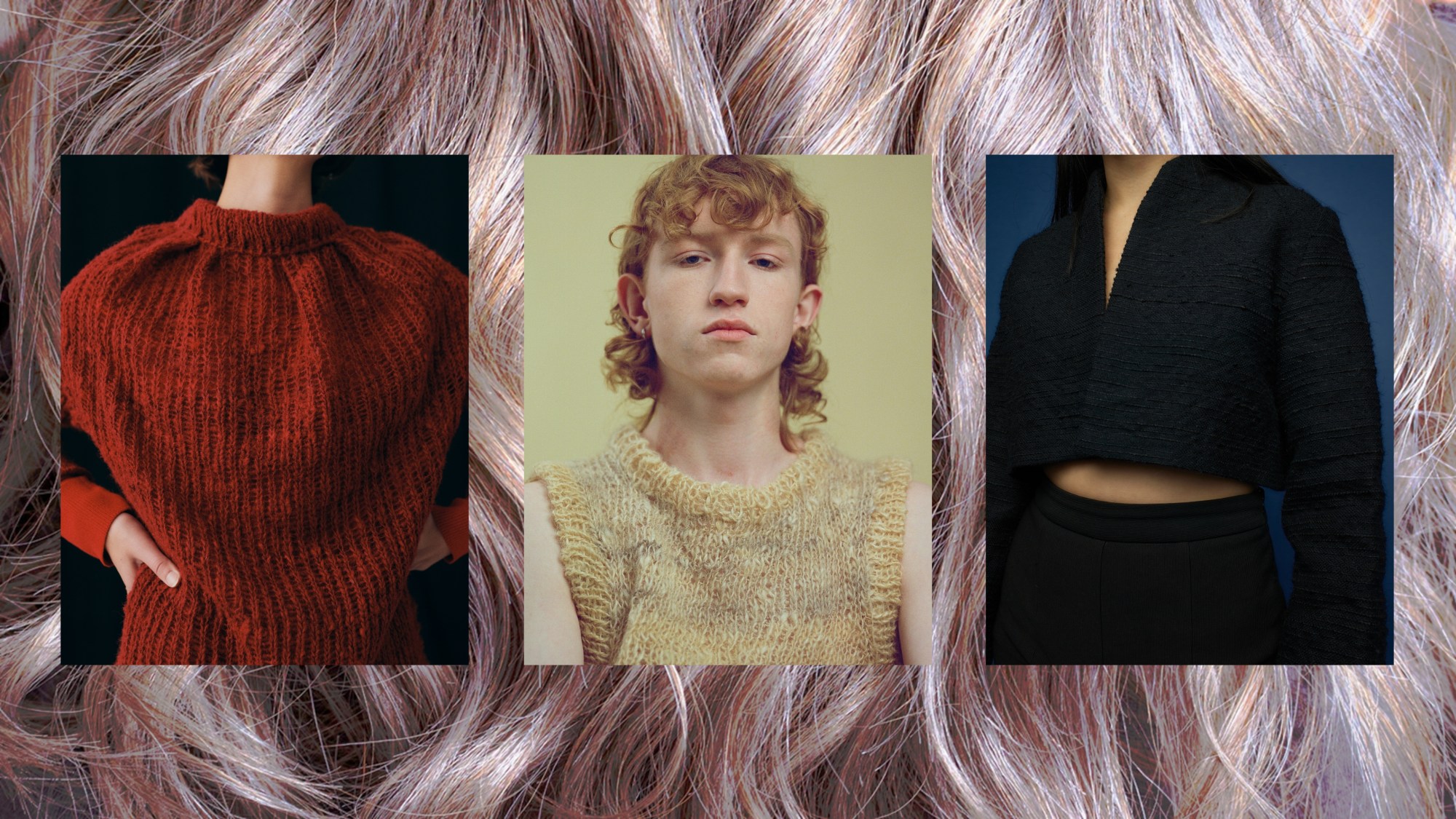Would you wear a jacket made from other people’s hair? Slipping into the tweed-like jacket Zsofia Kollar developed, this seemingly far-out concept becomes very real. The piece is well-tailored, much like the iconic Chanel version, except its coarse black weave is made partially of human hair. Strange? Not for Zsofia. As the founder of Human Material Loop (a Dutch-based scientific company developing fabric from tossed-away hair clippings), this is her bread and butter.
In addition to the jacket, Zsofia owns a collection of sample tweeds – crafted with a recycled wool warp and a 100% human hair weft, as there wasn’t enough hair yarn, she says, to equip the weaving machine in the sampling process – as well as 100% human hair chunky knits. While that may all sound like the sort of thing you’d find on a macabre Etsy, rest assured it isn’t. Next year, the public will see the results of the company’s rapidly scaling business via a series of partnerships with to-be-revealed luxury fashion houses. “We want to provide an alternative to synthetic fibres that is natural and has a quality of wool,” explains Zsofia. She uses a closed-loop recycling process, meaning the hair fibres can be recycled and reused again and again, without losing their inherent properties. This makes them infinitely more sustainable than their synthetic or woollen counterparts. They’re also heat-retentive, antibacterial, durable and hypoallergenic. Still, for their many merits, they incite many strong reactions. Namely: “Ew!”

Why? After all, hair has enjoyed plenty of high-fashion moments. Ann Demeulemeester and Helmut Lang have both toyed with fetishistic accessories from horsehair. Margiela’s iconic wig coat (although synthetic) deserves a mention too. And when it comes to human hair, Charlie Le Mindu is a great example. The hair-stylist-turned-creative-director has turned heads (and the hair on them) with his costumes made of human hair extensions, and his hair clutches (a collab with French accessories brand Cahu).
Fashion East’s AW20 show included a dainty cropped vest by Gareth Wrighton, knitted from the designer’s own clippings, while some of Alexander McQueen’s earlier creations contained locks of hair trapped inside a clear perspex pocket. Initially McQueen’s own, these ‘hair labels’ symbolised the designer giving himself to his collection: an idea inspired by Victorian times. Back then, wearing someone else’s hair was quite a fashionable thing to do. Often, the hair in question belonged to a deceased loved one and was incorporated into lavish jewellery, like a talisman to help you grieve (although less frequently, similar pieces are still worn today), though some Victorians also wore hair from their living lovers, friends or family members, as a token of affection.
Whether it once belonged to a designer or a loved one, in fashion, human hair is often used to signal a connection between its previous owner and its new wearer. That might be far from the anonymous raw material Zsofia envisions it to be, but perhaps it makes sense. After all, hair – when still attached to our heads – defines us. Plus, the human hair trade is notoriously shady. In India, China and Eastern Europe, there are numerous reports of hair agents touring low-income villages to buy local women’s hair, often for tiny sums. And there are further reports of temples that made vast profits off the sale of their visitors’ hair sacrifices, unbeknownst to the donors themselves.
Although this hair is meant for the booming business of human wigs and hair extensions, it does emphasise the need for ethically-sourced hair textiles. So how does that work for Human Material Loop? Zsofia uses “whatever a hairdresser sweeps from the floor” — something the company can trace from hair salon to factory to manufacturer. This still-in-development material passport serves both consumers who are assured they’re wearing something ethically sourced) and hair salons (who know their waste is actually being used). “But I’m secretly hoping it’ll push consumers to demand more ethical sourcing for their hair extensions, too,” Zsofia adds. Except for wig donations, any hair is welcome, and Human Material Loop’s yarns are a mixture of various hair clippings.
This means that a Human Material Loop-made jumper is more ethical, sustainable and traceable than the majority of clothes out there. Yet, the idea of wearing one can still feel icky. It’s the same kind of icky that makes people cringe at a jumper made of cat hair, while gleefully wearing a woollen number themselves. “I think it’s because, often, sheep don’t have a name,” Zsofia muses. “As humans, we have a name and so do our pets, like cats and dogs. I think that’s something we can’t overcome psychologically.”
In his book, De Fundamenten, Dutch-Palestinian author Ramsey Nasr writes about an art experiment that vindicates Zsofia’s practice. The inhabitants of a Rotterdam neighbourhood were encouraged to raise two pigs. Arie and Japie lived a good, love-filled life. Until the artist duo responsible for the experiment announced that the pigs would be butchered and eaten at a neighbourhood BBQ – to which everyone was invited. Unsurprisingly, the neighbourhood rebelled. But weren’t Arie and Japie a more healthy, ethical alternative to the store-bought meat the neighbours were already eating? As you might expect, treating animals like cogs in an industrial machine makes it easier for us to consume them. “Name an animal and treat it with love,” Nasr writes, “and we grow a conscience”.
Of course, under a fashion system that pushes overconsumption for the sake of profit, all fibres (whether plant-derived, animal-derived or synthetic) come with their own controversies – and human hair certainly isn’t without its own. Whether stuffed into McQueen’s labels or attached to Le Mindu’s bags, human hair has always had the capacity to make a fashion statement. Although her approach is more practical, Zsofia’s hair fabrics are no different. They make people uncomfortable because they challenge the way we consume fashion, raising obvious yet long-avoided questions the way a child does: What really makes us so different from sheep? Why are we always the consumer and never the consumed? Why do we spoil so much in an attempt to make pretty things, only to toss those things after a season?
More than anything, Zsofia’s fabrics are destined to become “garments that last for generations”. That’s partially because human hair is incredibly durable, but mostly because these garments force us to consider where – or rather, whom – they came from. Perhaps a name is exactly what we need in order to treat our clothes with love.



